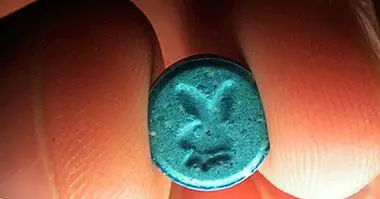The 4 types of marijuana: cannabis and its characteristics
Cannabis is the most widely used illegal drug in the world , being its most well-known and popular form marijuana. Used for millennia as a medicinal element, today it is mainly used as a recreational drug or as an auxiliary method in the fight against the effects of certain ailments.
But we must bear in mind that there is not only one type of marijuana, but that both nature and human action have led to the existence of hundreds of varieties. In this article we will know some of the types of marijuana that exist, as well as their basic characteristics.

Cannabis as a psychoactive substance
Cannabis is a substance with psychoactive properties. Along with its derivatives, among which is marijuana, is part of the group of psychodysleptics. It is a type of substance that produces alterations in psychic activity and perception .
The consumption of cannabis tends to produce an increase in the activation and feeling of euphoria at first and then leave the consumer a relaxing effect (being used by many users in order to reduce feelings of anxiety and stress). It also causes the sensation of hunger and has anti-emetic and anticonvulsant effects and even reduces the sensation of pain having analgesic effects. It is possible that disorientation and alterations of consciousness appear, and in some cases hallucinations can even appear.
Marijuana
Cannabinoids are extracted from the cannabis plant, which has different varieties . In practice, the derivatives of this plant receive a different name according to which part of the plant they come from, or in what way the product consumed is obtained.
We speak of marijuana when the element consumed is the leaves and stem of the plant, being as a rule consumed in a smoked form (although sometimes it is also ingested orally, as is the case with those known as "cakes de maría" or in the form of infusion).
Main types of marijuana
As we said, there are a large number of marijuana variants, depending on the plant from which the leaves and stem are obtained . Regardless of its origin, there are other factors that can alter existing types of marijuana, such as the amount of light needed by the plant, the type of flowering that it has (it can be a regular, feminized or autoflowering plant) or the time of year in what is obtained. An example is the moment in which it is collected or the quantity that each variety needs. For example, purple marijuana occurs due to the accumulation of certain substances during abrupt temperature changes.
Then We indicate the three main types that can be found naturally , from which the hundreds of existing varieties have been hybridized and elaborated by means of artificial selection.
1. Cannabis sativa
Originally from countries with a tropical climate, cannabis sativa is one of the best known cannabis plant varieties. In fact, the typical leaf that people usually imagine when talking about marijuana is usually of this variety. We are facing one of the most consumed types of marijuana, generally from South America or Asia. They tend to be tall plants, being the most frequent to see in outdoor plantations.
The psychoactive effects of marijuana extracted from this variety tend to be activating and psychoactive due to its high amount of delta-9-tetrahydrocannabinol or THC. Stimulates appetite and physical and social activity, causing feelings of euphoria. In many cases its consumption is also associated with the presence of hallucinations, which may increase the possibility of triggering psychotic episodes and even contribute to the manifestation of disorders such as schizophrenia.
2. Indica Cannabis
Of Asian origin, it is one of the types of marijuana that can be found naturally, especially in countries such as India or Pakistan. This variety has an intermediate size, also having much wider leaves than other varieties.
Regarding the type of effects, the indica variety usually has a slightly narcotic effect more linked to physical relaxation and analgesia , having a high content of cannabidiol or CBD and low in THC. This variety is what is usually indicated medically, its use being frequent in the treatment of pain caused by different diseases, as well as its anticonvulsant and relaxing effects.
3. Cannabis Ruderalis
In countries such as Russia or Siberia, a third natural variety cannabis ruderalis can be found. This plant, although sometimes considered a variety of cannabis sativa, has the peculiarity that it has great strength and the ability to bloom regardless of the level of luminosity.It is usually used in hybridization to create other varieties because of it.
Small in size, low in THC and high in CBD, so its effects are more relaxing than activators and sometimes it is used medicinally.
4. Hybrids
The three previous varieties of cannabis and marijuana can be found naturally. But nevertheless, based on them the human being has been creating different varieties in order to obtain different effects or increase resistance or proliferation , through artificial selection in nurseries and plantations.
The type of effect obtained in each case depends on the type of hybrid that has been created and its origin. That is why this category is much more heterogeneous than the previous ones, since the combinations and the crossing of genes make the variety of products obtained very broad.
Uses and risks of marijuana
As mentioned above, marijuana use has very different uses. Its effects, together with the social perception that it does not cause as many adverse effects as other drugs, mean that, despite being an illegal drug, it is consumed with great frequency by a large part of the population.
The recreational use of different types of marijuana can be harmful , especially when the consumption is high and frequent. It is usually used as an element that helps to relax or to obtain a feeling of well-being. Although the dependence on this substance is not usual, requiring almost daily consumption, and abstinence syndromes have not been generally described, it is not strange that situations of intoxication and abuse appear.
Delusions and hallucinations (especially in the case of the sativa variety), disorientation, flashbacks or even reactions opposite to those that the substance should produce (depression and inhibition in the case of sativa and agitation and anxiety in the indica) are phenomena that can occur after prolonged consumption and / or in high quantity. The so-called amotivational syndrome has also been described, in which extreme passivity appears, decreased judgment, apathy and demotivation.
But nevertheless, If this substance is used medically it is also a relief for many people suffering from different disorders. . Since it stimulates the appetite they have been used sometimes to combat anorexia and weight loss secondary to other diseases (such as AIDS), as well as alleviate problems such as fibromyalgia or the pain caused by cancer or the discomfort associated with some of their treatments. Its anticonvulsive effects are also interesting, and can be used to regulate different types of crises. You can even see some cases of individuals with Parkinson's whose tremors have been reduced and even temporarily eliminated during the action of the drug.
Bibliographic references:
- Moore, T.H.M .; Zammit, S .; Lingford-Hughes, A .; Barnes, T.R.E .; Jones, P.B .; Burke, M. & Lewis, G. (2007). Cannabis use and risk of psychotic or affective mental health outcomes: a systematic review. The Lancet. volume 370, 9584; p.319-328.
- Santos, J.L. ; García, L.I. ; Calderón, M.A. ; Sanz, L.J .; de los Ríos, P .; Left, S .; Román, P .; Hernangómez, L .; Navas, E .; Thief, A and Álvarez-Cienfuegos, L. (2012). Clinical psychology. CEDE Preparation Manual PIR, 02. CEDE. Madrid.



















